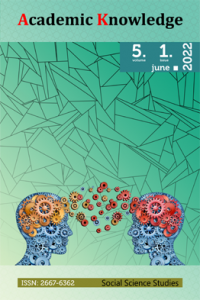Nüzul Tertibine Göre Tefsir Yazımı ve Nüzul Tertibini Esas Alan Tefsirler
Kur’ân, Nüzûl Tertîbi, Tefsir, Mekkî Sureler, Medenî Sureler
Tafsīr Writing According to the Nuzūl Sequence and Tafsīrs Which Basıs Nuzūl Sequence
Qur’an, Revelation Order, Tafsîr, Mecca Surahs, Medinah Surahs,
___
- Abduh, M. ve Rızâ, M. R. (1990). Tefsîru’l-Kur’âni’l-Hakîm (Tefsîru’l-Menâr). Mısır: Heyetu’l-Mısriyyetu’l-Âmmetu li’l-Kitab.
- Buhârî, M. (h.1311). el-Câmiu’s-Sahîh, (M. en-Nasır, Thk.). Mısır: Dâru’t-Tevkinü’n-Necat.
- Câbirî, M.A. (2014). Fehmu’l-Kur’ân Nüzul Sırasına Göre Tefsir. (M. Çoşkun, Terc.). İstanbul: Mana Yayınları.
- Çalışkan, N. (2013). Nüzul Sırasına Göre Yeni Bir Tefsir, Abdurrahman Hasan Habenneke el-Meydânî ve Meâricü’t-Tefekkür. Toplum Bilim Dergisi, (VII-14), 363-373.
- Çalışkan, N.(2013). Abdurrahman Hasan Habenneke el-Meydânî ve Tefsiri. Doktora Tezi, Ankara Üniv. Sos. Bil. Enstitüsü, Ankara.
- Derveze, M. İ. (2000.) et-Tefsîru’l-Hadîs Tertîbu’s-Süver Hasebe’n-Nüzul. Beyrut: Dâru’l-Garbi’l-İslâmî.
- Duman, M. Z. (2009). Neden Yeni Bir Tefsir? Beyânu’l-Hak Adlı Eserimizin Özellikleri ve Tefsire Getirdiği Yenilik Hakkında Bir Deneme. Türk Bilimsel Derlemeler Dergisi, (II-1), 105-115.
- Duman, M. Z. (2014). Beyânu’l-Hak Kur’ân-ı Kerîm’in Nüzul Sırasına Göre Tefsiri. İstanbul: Kayseri Gündem Gazetesi Basımı.
- Fâris, T. M. (2011). Tefasiru’l-Kur’âni’l-Kerîm Hasebe Tertibî’n-Nüzul. Amman: Dâru’l-Feth li’-Dirâsât ve’n-Neşr.
- Geçit, M. S. (2013). Tefsirde Hz. Ali, Yüksek Lisans Tezi, Iğdır Üniversitesi Sosyal Bilimler Enstitüsü, Iğdır.
- Gözeler, E. (2009). Kur’ân Âyetlerinin Tarihlendirilmesi Sorunu ve Kur’ân’a Kronolojik-Olgusal Bir Yaklaşım (1Rebi’ül-Evvel-4Rebi’ül-Evvel Arası). Doktora Tezi, Ankara Üniv. Sosyal. Bilimler Enstitüsü, Ankara.
- İslamoğlu, M. (2014). Kur’ân’ı Anlama Yöntemi Tefsir Usulü, İstanbul: Düşün Yayıncılık.
- John W. (1977). Quranic Studies: Sources and Methods of Scriptural Interpretation, Qxford: Oxford University Press.
- Kahraman, M. Ş. (2016). Kur’ân’ın Nüzul Sırasına Göre Tefsiri. Yüksek Lisans Tezi, İnönü Üniversitesi Sosyal Bilimler Enstitüsü, Malatya.
- Kasapoğlu, A. (2014). Kur’ân’da “Tenzîl” Kavramına Eğitim Açısından Bir Yaklaşım. İnönü Üniversitesi İlahiyat Fakültesi Dergisi, (sy. 5), 41-84.
- Koçyiğit, H. (2013). Kur’ân’ın Nüzul Sırasına Göre Tefsir Edilmesi. Hitit Üniversitesi İlahiyat Fakültesi Dergisi, (XII-23), 183-201.
- Mollâ Huveyş, A. (1962). Tefsîru Beyâni’l-Me’ânî. Dımaşk: Matbaatü’t-Terakkî.
- Müslim. (1998). el-Câmiu’s-Sahîh. Riyâd: Beytü’l-Efkâr ed-Düveliyye.
- Okumuş, M. (2009). Kur’ân’ın Kronolojik Okunuşu. Ankara: Araştırma Yayınları.
- Öztürk, M. (2016). Nüzul Sırasına Göre Kur’ân-ı Kerim Meali. Ankara: Ankara Okulu Yayınları.
- Paçacı, M. (2006). Kur’ân’a Giriş. İstanbul: İsam Yayınları.
- Editör). Tefsir El Kitabı. Ankara: Grafiker Yayınları.
- Râzî, F. (1985). Mefâtihu’l-Gayb (et-Tefsîru’l-Kebîr). Beyrut: Dâru Fikr.
- Suyûtî, C. (trs). el-İtkân fî Ulûmi’l-Kur’ân. Mısır: yy.
- Şâtıbî, İ. (1997). el-Muvafakat fi Usûli’d-Din. (E.U.Meşhur, Thk.). Huber: Dâru İbn Affân.
- Şimşekçakan, M. (2014). Sözün Gücü İlahi Vahyin Rehberliği. İstanbul: Düşün Yayıncılık.
- Türcan, S. (2010). Kur’ân’ın İfade Kalıpları Nüzul Kronolojisini Aydınlatabilir mi? Müzzemmil Suresi Örneğinde Bir Yöntem Denemesi. Hitit Üniversitesi İlahiyat Fakültesi Dergisi, (IX-17), 67-100.
- Wansbrough, J. (1977). Quranic Studies: Sources and Methods of Scriptural Interpretation, Qxford: Oxford University Press.
- Watt, W. M. (2006). Kur’ân’a Giriş. (S. Kalkan, Çev.). Ankara: Ankara Okulu.
- Yazıcı, A. (2011). Klasik-Modern Yorum Açısından Bilmen ve Ateş Tefsirlerinin Mukayesesi. Doktora Tezi, On Dokuz Mayıs Üniversitesi Sosyal Bilimler Enstitüsü, Samsun.
- Yazır, M. H. (2011). Hak Dini Kur’ân Dili. (İ.Karaçam ve bşk, Sad.). İstanbul: Azim Dağıtım (Milliyet gazetesi Basımı).
- Zurkânî, M. A. (1995). Menâhilu’l-İrfân fî ‘Ulûmi’l-Kur’ân. (A. Zümerli, Thk.). Beyrut: Kitabu’l Arabî.
- İnternet Kaynakları:
- http://darulkitap.kuranikerimde.com
- https://istekuran.net/sureler.
- ISSN: 2667-6362
- Yayın Aralığı: Yılda 2 Sayı
- Başlangıç: 2018
- Yayıncı: Taner NAMLI
ارتفاع نسبة الطلاق في الخليج دراسة فقهية تحليلية
et-Teşeyyüʿ ve’ş-Şîa, Ahmed el-Kesrevî
Nüzul Tertibine Göre Tefsir Yazımı ve Nüzul Tertibini Esas Alan Tefsirler
Allah İnancında Aşırılık ve İtidal Örnekleri
Cuma Namazının Sıhhati İçin Öngörülen Cemaât Sayısı Üzerine Bir İnceleme
Avrupa Birliği’nin Uluslararası Terörizmle Mücadele Stratejileri
